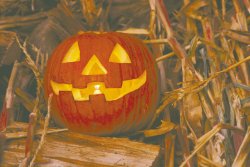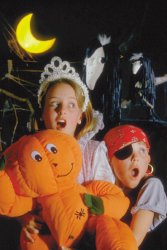 Should
you let your children celebrate Halloween?
Should
you let your children celebrate Halloween?A History of Halloween
Should Our Kids Celebrate
Halloween?
Good news! Trick or treating doesn’t jeopardize our faith
By Augustine Thompson, O.P.
 Should
you let your children celebrate Halloween?
Should
you let your children celebrate Halloween?
What was once thought to be a harmless holiday is now said — by some — to be a pagan rite dating back to Celtic (and pagan) Druids. What’s more, it’s claimed that modern pagans and witches continue to celebrate this ancient festival even today.
The truth is that the origins of Halloween are, in fact, very Christian, and rather American, too. Halloween actually falls on October 31 because of a pope, and its observances are the result of medieval Catholic piety.
It’s true that the ancient Celts of Ireland and Britain celebrated a minor festival on October 31 — as they did on the last day of most other months of the year. However, Halloween falls on the last day of October because the Feast of All Saints or “All Hallows” falls on November 1. The feast in honor of all the saints in heaven initially was celebrated on May 13, but Pope Gregory III (d. 741) moved it to November 1, the dedication day of All Saints Chapel in St. Peter’s at Rome. Later, in the 840s, Pope Gregory IV commanded All Saints to be observed everywhere. The day before the feast’s evening vigil, then, came to be called “All Hallows Even” or “Hallowe’en.” But in those days, Halloween didn’t have any special significance for Christians (or for the long-dead Celtic pagans, either).
By 998, St. Odilo, the abbot of the powerful monastery of Cluny in southern France, had added a celebration on November 2. This was a day of prayer for the souls of all the faithful departed. Called All Souls Day, this feast spread from France to all of Europe. So the Church now had feasts for those in heaven and those in purgatory.
What about those in the other place? It seems
Irish Catholic peasants wondered about the unfortunate souls in hell. After all,
if the souls in hell are left out when we celebrate those in heaven and
purgatory, they might be unhappy enough to cause trouble. So it became customary
to bang pots and pans on All Hallows Even to let the damned know they were not
forgotten.
 But
what about our dressing up in all sorts of fanciful costumes? The wearing of
costumes on All Souls Day began in France during the 14th and 15th centuries.
When late medieval Europe was hit by repeated outbreaks of the bubonic plague
— the black death — about half its population was wiped out. It is not
surprising that Catholics became more concerned about the afterlife at this
time. More Masses began to be said on All Souls Day, and artistic
representations were devised to remind people of their own mortality.
But
what about our dressing up in all sorts of fanciful costumes? The wearing of
costumes on All Souls Day began in France during the 14th and 15th centuries.
When late medieval Europe was hit by repeated outbreaks of the bubonic plague
— the black death — about half its population was wiped out. It is not
surprising that Catholics became more concerned about the afterlife at this
time. More Masses began to be said on All Souls Day, and artistic
representations were devised to remind people of their own mortality.
We know these representations as the “Dance of Death,” which came to be painted on the walls of many cemeteries of the day. Showing the devil leading a daisy chain of people — popes, kings, ladies, knights, monks, peasants, lepers, etc. — the Dance of Death leads in one direction, into the tomb. Sometimes the dance was presented on All Souls Day itself as a living tableau; people dressed up in the garb of the various states of life to hit the point home.
But the French dressed up on All Souls, not Halloween; and the Irish, who had Halloween, did not dress up at all. The two became mingled probably in the British colonies of North America during the 1700s, when Irish and French Catholics began to intermarry.
But, as every young ghoul knows, dressing up isn’t the point; the point is getting as many goodies as possible.
Where on earth did “trick-or-treat” come in? Trick-or-treating, perhaps the oddest and most American addition to Halloween, is a contribution of the English.
During the penal period of the 1500s to the 1700s in England, Catholics had no legal rights: They could not hold office and they were subject to fines, jail, and heavy taxes. It was a capital offense to say Mass, and hundreds of priests were martyred.
Occasionally, of course, English Catholics resisted, sometimes foolishly. One of the most ill-fated acts of resistance involved a plot to blow up the Protestant King James I and his Parliament with gunpowder. This was supposed to trigger a Catholic uprising against their oppressors. But the ill-conceived “Gunpowder Plot” was foiled on November 5, 1605, when the person guarding the gunpowder, a reckless convert named Guy Fawkes, was captured and hanged.
Thus, November 5 — Guy Fawkes Day — became a great celebration in England and remains so today. During the penal period, bands of revelers began donning masks on this date and visiting local Catholics in the dead of night, demanding beer and cakes for their celebration: trick-or-treat!
Consequently, Guy Fawkes Day arrived in the colonies with the first English settlers. And although old King James and Guy Fawkes had pretty much been forgotten by the time of the American Revolution, trick-or-treating was too much fun to give up. In time, it was moved to October 31, the traditional day of the Irish-French Dance of Death masquerade.
The mixture of various immigrant traditions into what we now know as Halloween had become a fixture in the United States by the early 1800s. To this day, it remains unknown in Europe, even in the countries from which some of the customs originated.
But what about witches? Well, they are a most recent addition. It seems that the greeting-card industry added them in the late 1800s. Halloween was already “ghoulish,” so why not give witches equal billing on greeting cards?
Though the Halloween cards failed, the witches stayed. So, too, in the late 1800s, ill-informed folklorists introduced the jack-o’-lantern, thinking that Halloween was pagan in origin. Since lamps made from turnips (not pumpkins) had been part of ancient Celtic harvest festivals, they, too, got added to the American Halloween.
So the next time someone claims that Halloween is a cruel trick to lure children into devil worship, consider relating the real origin of All Hallows Even. Invite your friends to discover the holiday’s Christian significance, along with the two greater and more important Catholic festivals that follow it.
Condensed from Catholic Parent, 200 Noll Plaza, Huntington, Ind. 46750. Sept./Oct. 1995. © 1995 Our Sunday Visitor Inc. Reprinted with permission.